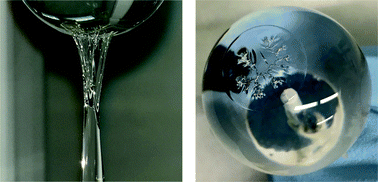Contact mechanics for polydimethylsiloxane: from liquid to solid
Abstract
Adhesion between a glass ball and a polydimethylsiloxane (PDMS) sample is dependent on the PDMS cross-link density, and the transformation of the material from the uncrosslinked liquid state to the fully crosslinked solid state is investigated in this study. The physical picture reflected a gradual transition from capillary forces driven contact mechanics to the classical Johnson–Kendall–Roberts (JKR)-type contact mechanics. PDMS was produced by mixing the base fluid and a cross-linker at a ratio of 10 : 1 and allowed to slowly cross-link at room temperature with simultaneous measurement of the ball–PDMS interaction force. The PDMS sample was in the liquid state during the first ≈16 hours, and in this case the ball–PDMS interaction was purely adhesive, i.e., no repulsive interaction was observed. Later at the PDMS gel-point the cross-linked PDMS clusters percolate, converting the fluid into a soft (fluid-filled) poroelastic solid. In the transition period, PDMS appears similar to pressure-sensitive adhesives. There we observe so-called “stringing” and permanent deformation of the material impacted by the ball. At room temperature, it takes more than ∼100 hours for PDMS to fully cross-link that can be confirmed by the comparison with the earlier-studied reference PDMS produced at elevated temperatures.



 Please wait while we load your content...
Please wait while we load your content...